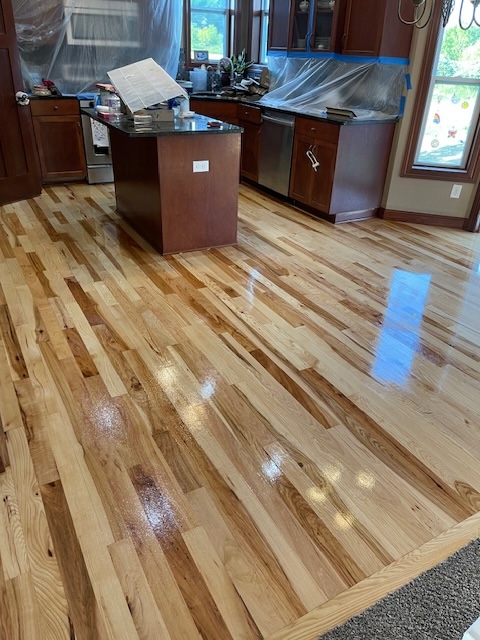Can I refinish hardwood floors myself?

Hardwood floors are a timeless and beautiful feature in many homes, adding warmth, character, and a touch of elegance to any space. Over time, however, even the most well-maintained hardwood floors can show signs of wear. Scratches, scuffs, fading, and dullness can accumulate, leaving your once-vibrant floors looking tired. If you’re considering bringing your hardwood floors back to life, refinishing them is a great solution. But the question is: Can you refinish hardwood floors yourself?
At Choice Hardwoods, we’ve seen countless homeowners weigh the pros and cons of DIY refinishing. While refinishing your hardwood floors can be a rewarding project, it’s important to be aware that it’s no small task. Sanding and refinishing hardwood floors is physically demanding, time-consuming, and requires the right tools and expertise. However, if you’re up for the challenge, you can save money and achieve a great result with the right approach.
In this article, we’ll walk you through the entire process of refinishing hardwood floors, share some key tips to make the process easier, and help you decide whether it’s a project you can take on yourself—or if it’s better to call in the professionals.
Understanding the Refinishing Process
Before diving into the “how,” it’s essential to understand what refinishing hardwood floors involves. The process of refinishing hardwood floors includes sanding the surface to remove the old finish, followed by staining the wood (if desired) and applying a fresh coat of polyurethane or other protective finish. Here’s a brief breakdown of the steps involved:
-
Sanding the Floor: This is the first and most crucial step in refinishing. Sanding removes the old, worn finish, stains, and imperfections, giving the wood a clean, smooth surface. It also helps to open up the wood’s pores so it can absorb new stain and finish properly.
-
Staining (Optional): After sanding, you can choose to apply a stain to change the color of your wood. This is optional, but it can enhance the look of your floors if you’re looking for a different tone or want to revive the wood’s natural hue.
-
Applying Finish: The final step is to apply a new protective finish, usually in the form of polyurethane. This step adds a layer of durability and shine, making your floors look brand new while protecting them from future wear and tear.
Why Refinishing Your Floors Is Hard Labor
Refinishing hardwood floors may seem like a straightforward task at first, but it involves several steps that are not only labor-intensive but also require attention to detail. Here are a few reasons why refinishing your hardwood floors is harder than it seems:
1. Physical Labor
Sanding hardwood floors is a physically demanding job. You’ll be operating heavy equipment, like a drum sander, which can weigh up to 80 pounds. The sander needs to be pushed and pulled across the floor, requiring strength and stamina, especially when working in large rooms. Additionally, sanding often involves hours of back-and-forth motion, which can be tiring.
2. Time-Consuming
Refinishing hardwood floors is not a weekend project for most people. Depending on the size of the area, it could take several days to properly sand, stain, and finish the floors. You’ll need to allow time for the finish to dry in between coats, which can take several hours or even a full day, depending on the type of finish used. You may also need to sand and apply multiple coats of finish, which can add days to the overall timeline.
3. Dust and Mess
One of the biggest challenges of refinishing hardwood floors yourself is dealing with the dust. Sanding produces a fine, powdery dust that can cover everything in the room—walls, furniture, vents, and even adjacent rooms. Without the right equipment, it’s almost impossible to contain the dust, which means a major cleanup job at the end. If you don’t have a professional dust containment system, such as a vacuum attached to the sander, you’ll be left cleaning up dust for hours after the project is complete.
4. Skill and Precision
While sanding may seem like a simple task, it requires a steady hand and a good eye. If you don’t sand evenly, you may end up with gouges or uneven patches in your floor, which can be difficult to fix without professional tools. Additionally, achieving the right finish requires precision and experience. Staining is particularly tricky, as uneven application can lead to streaks or blotches that are hard to correct.
The Step-By-Step Process for Refinishing Hardwood Floors
If you’re still interested in tackling the refinishing process yourself, here’s a step-by-step guide to help you along the way. Keep in mind that preparation and safety are key, and the right tools are essential for achieving the best results.
Step 1: Preparation and Safety
Before you start, prepare the room by removing all furniture, rugs, and any other items from the area. Cover any nearby fixtures (like light fixtures or baseboards) with plastic or painter’s tape to protect them from dust and finish. Make sure the area is well-ventilated, as the fumes from sanding and finishing can be harmful if inhaled.
Safety Gear: Always wear safety glasses, a dust mask (or respirator), and ear protection while sanding to protect yourself from dust, flying debris, and the loud noise of the equipment.
Step 2: Sanding the Floor
The first step in refinishing is sanding, which will remove the old finish and smooth the surface. You’ll need three main pieces of equipment for this step:
-
Drum Sander: This is the primary tool used to sand the floor. The drum sander is heavy and powerful, so it’s important to know how to operate it properly. Be sure to keep the sander moving consistently, as staying in one place for too long can cause uneven sanding or gouges.
-
Edge Sander: A drum sander can’t reach the edges of the room, so you’ll need an edge sander to finish the areas near the baseboards and corners. This tool is smaller and more maneuverable, but it requires a steady hand to avoid creating uneven marks.
-
Sandpaper: Start with a course-grit sandpaper (around 36 to 40 grit) to remove the old finish, then move to a finer grit (60 or 80) to smooth the floor. Finish with an even finer grit (100 or 120) to give the floor a polished look.
When sanding, work in small sections, moving with the grain of the wood. After each pass, check the floor for any imperfections and sand over them as needed.
Step 3: Cleaning the Floor
After sanding, you’ll need to vacuum the floor thoroughly to remove all the dust. It’s important to do a detailed cleaning because any dust left behind can affect how the stain and finish adhere. Wipe the floor down with a damp cloth to remove any residual dust, and let the wood dry completely before proceeding.
Step 4: Staining (Optional)
If you choose to stain the wood, this is the time to do it. Staining is a personal choice and can significantly change the look of your hardwood floors. Choose a wood stain that complements your home’s decor, and apply it evenly using a brush, rag, or sponge. Work in small sections, and always follow the manufacturer’s instructions for application and drying times.
Staining can be tricky, especially when trying to achieve a uniform color across the entire floor. Be sure to blend your strokes and wipe off excess stain as you go to avoid blotches. If you’re uncertain about the color, consider testing the stain in a small, inconspicuous area first.
Step 5: Applying Finish
Once the stain is dry (if you’ve chosen to stain), it’s time to apply the polyurethane finish. This finish will protect the wood from damage and give it a shiny, polished look. Polyurethane comes in both oil-based and water-based varieties. Oil-based finishes are more durable and give a warm, amber hue, but they take longer to dry. Water-based finishes dry faster and provide a clear, bright finish, but they’re not as durable as oil-based finishes.
To apply the finish, use a high-quality finish applicator (such as a lambswool applicator or a foam brush), and apply it evenly in long, smooth strokes. Be sure to follow the wood grain to avoid streaking. Apply at least two to three coats of finish, allowing each coat to dry fully before applying the next. Lightly sand the surface with fine-grit sandpaper between coats to ensure good adhesion.
Step 6: Finishing Touches and Drying Time
Once the final coat of finish is applied, let the floors dry completely—this can take anywhere from 24 to 48 hours, depending on the type of finish and the humidity level in your home. Avoid walking on the floors until they are fully dry, and be cautious when moving furniture back into the room, as it could scratch the new finish.
Is It Worth Refinishing Hardwood Floors Yourself?
Refinishing hardwood floors can certainly be done yourself, but it’s important to weigh the challenges against the benefits. Refinishing is physically demanding and time-consuming, and even with the right tools, achieving a professional finish requires skill and experience. The dust alone is a huge factor to consider, as it can make the process overwhelming and more difficult to manage.
If you’re looking for a rewarding DIY project and you have the time and patience, refinishing your floors could be a fun and cost-effective way to refresh your home. However, if you’re unsure about your ability to handle the process, or if you’d prefer to leave it to the experts, Choice Hardwoods is here to help.
Why Choose Choice Hardwoods for Professional Refinishing?
At Choice Hardwoods, we’ve been refinishing hardwood floors for years, and we know exactly how to handle any job, big or small. Our professionals come equipped with top-of-the-line tools, including dustless sanding systems, which help to keep the mess and dust to a minimum. We also ensure a smooth, even finish that will last for years to come.
If you don’t want to take on the physical labor, stress, and mess of refinishing your hardwood floors yourself, we’re here to provide expert refinishing services. With our experience and high-quality finishes, we can make your floors look brand new again—without the hassle.
Conclusion
While refinishing hardwood floors yourself is possible, it’s a labor-intensive project that requires time, effort, and attention to detail. If you’re up for the challenge, following the proper steps and using the right equipment can help you achieve beautiful results. However, if you prefer to leave the work to the professionals, Choice Hardwoods offers expert refinishing services that will restore the beauty of your floors while saving you time and frustration. Let us handle the hard work so you can enjoy your beautiful, refreshed floors for years to come!

